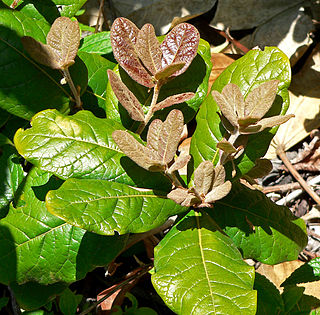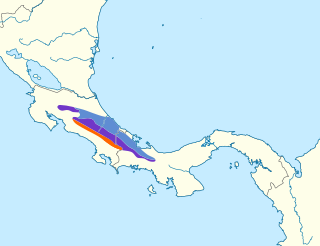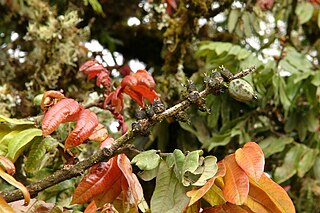Related Research Articles

Selenicereus costaricensis or Hylocereus costaricensis, known as the Costa Rican pitahaya or Costa Rica nightblooming cactus, is a cactus species native to Costa Rica and Nicaragua. The species is grown commercially for its fruit, called pitaya or pitahaya, but is also an impressive ornamental vine with huge flowers. Its scientific name is problematic for several reasons. The species may not be distinct from Selenicereus monacanthus.

Quercus costaricensis is a species of oak native to Central America. It is often found with Quercus copeyensis in the upper montane forests, to 3100 meters elevation. The leaves are tough and leathery with a short petiole and toothed margin. Wind is the primary pollinator. Squirrels are their main seed predator but also their main disperser as they commonly lose their buried seeds.

The blue-fronted parrotlet is also known as the red-winged parrotlet. It is a parrot in N. South America from E. Panama down the west coastal Andes to Peru, with a second population around and south of Lake Maracaibo. It is 15 cm, green with a short tail, blue forehead with narrow band of red under eye, red shoulders and leading edge of underwing, and the remaining underwing coverts yellow. Edges of tail also yellowish.

The red-fronted parrotlet is a parrot in Central America in Costa Rica and Panama. It is 15 cm, green with a short tail, red forehead, lores, and under eye, red shoulders and leading edge of underwing, and the remaining underwing coverts yellow. Edges of tail also yellowish.

Phyllachoraceae is a family of sac fungi.

A pitaya or pitahaya is the fruit of several different cactus species indigenous to the Americas. Pitaya usually refers to fruit of the genus Stenocereus, while pitahaya or dragon fruit refers to fruit of the genus Selenicereus, both in the family Cactaceae. Dragon fruit is cultivated in Mexico, Southeast Asia, India, the United States, the Caribbean, Australia, Mesoamerica and throughout tropical and subtropical world regions.

Alfaroa costaricensis, also known as campano chile, chiciscua, gaulin, gavilán Colorado, or gavilancillo, is nut bearing timber tree in the Juglandaceae family. It is native to the Neotropics, from Mexico, through Central America to Colombia.

The Costa Rican brushfinch or grey-striped brushfinch is a species of bird in the family Passerellidae. It is found in the undergrowth of humid forest, especially near the edges, at altitudes of 300 to 1,200 metres in Panama and Costa Rica.

Angiostrongylus is a genus of parasitic nematodes in the family Metastrongylidae.

Stanhopea costaricensis is a species of orchid endemic to Central America.
Angiostrongylus costaricensis is a species of parasitic nematode and is the causative agent of abdominal angiostrongyliasis in humans. It occurs in Latin America and the Caribbean.
The Costa Rica worm snake is a species of snake in the Typhlopidae family.
Hesperocharis costaricensis, the pallid tilewhite or Costa Rican white, is a butterfly in the family Pieridae. It is found from Mexico, through Central America to Venezuela.
Symphlebia costaricensis is a moth of the subfamily Arctiinae first described by Rothschild in 1909. It is found in Costa Rica and Guatemala.

Comarostaphylis arbutoides is a species of shrub in the heath family. Its range extends from central Mexico south to Guatemala, Honduras, Nicaragua, Costa Rica, and western Panama. It is found in oak and pine forests in mountainous locations, and on the summits of Central American volcanoes, at elevations from 1,350 to 3,800 m. There are two subspecies: arbutoides, distinguished by the presence of a rust-colored tomentum on the leaf underside, and costaricensis which lacks the tomentum.
Pseudestoloides is a genus of longhorn beetles of the subfamily Lamiinae, containing the following species:
Pseudestoloides affinis is a species of beetle in the family Cerambycidae. It was described by Martins and Galileo in 2009. It is known from Costa Rica.
Pseudestoloides hiekei is a species of beetle in the family Cerambycidae. It was described by Breuning in 1974. It is known from Mexico.
Pseudestoloides rubiginosa is a species of beetle in the family Cerambycidae. It was described by Martins and Galileo in 2009. It is known from Costa Rica.
References
- ↑ BioLib.cz - Pseudestoloides costaricensis. Retrieved on 8 September 2014.